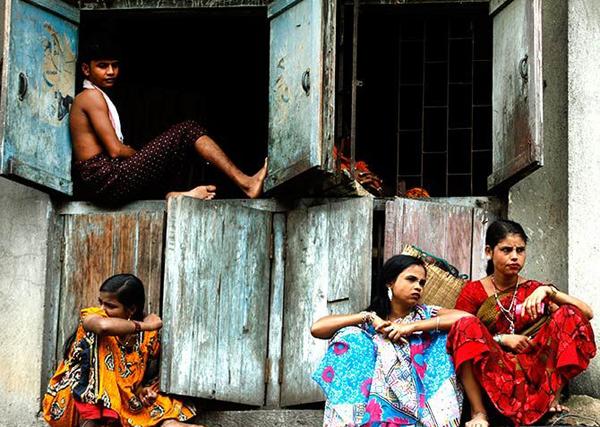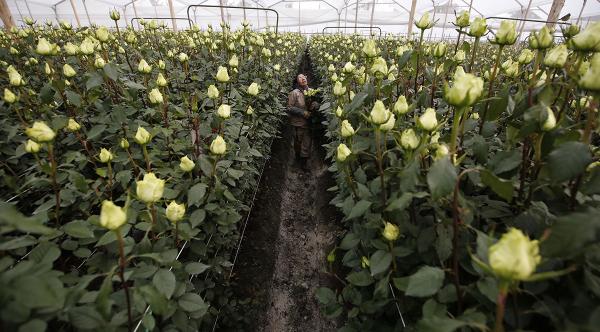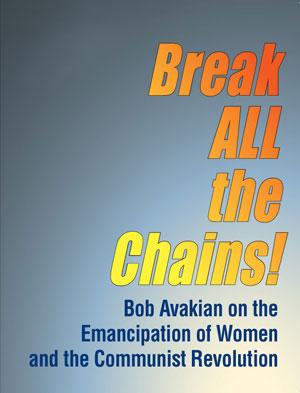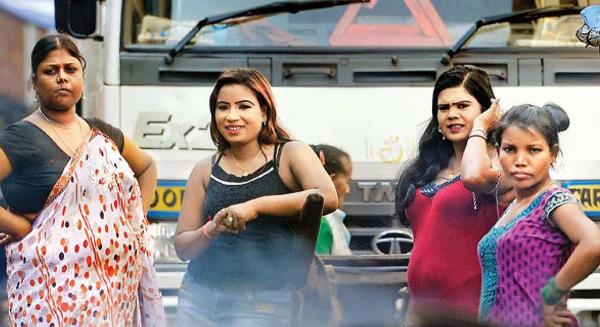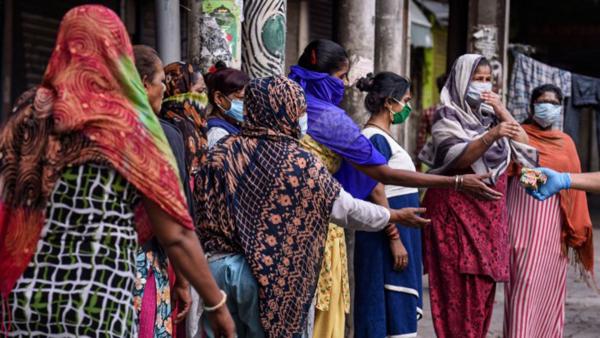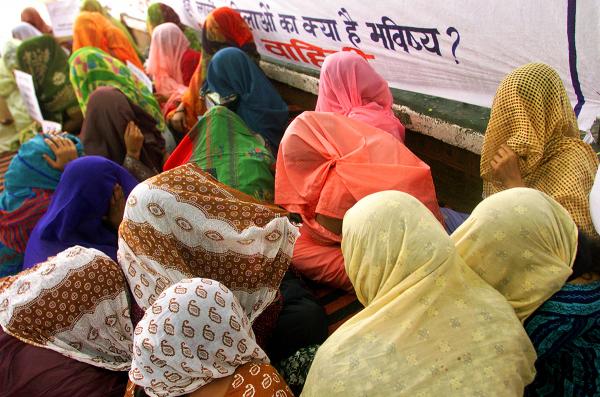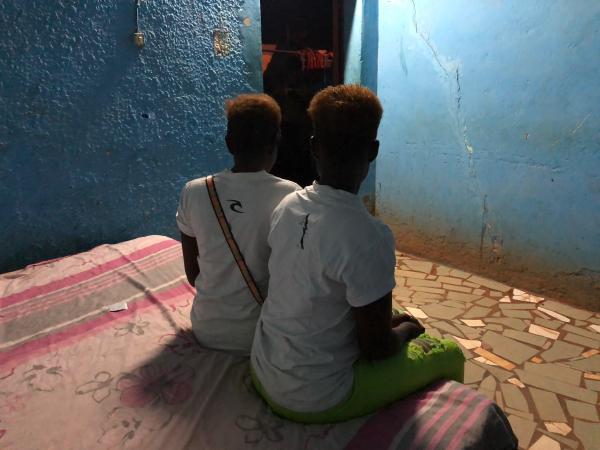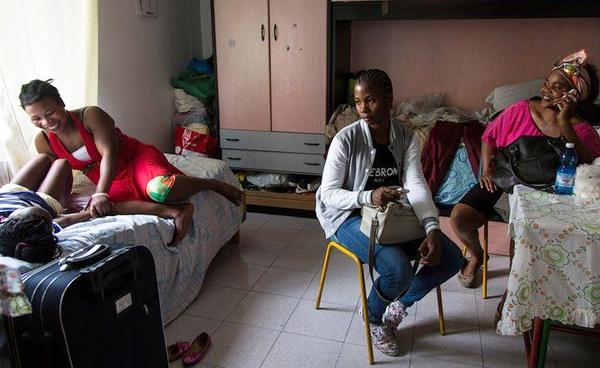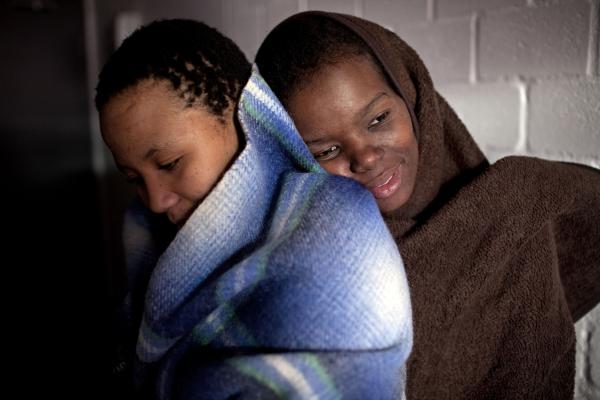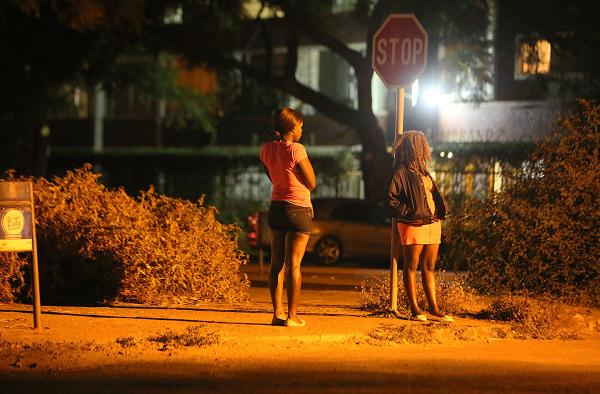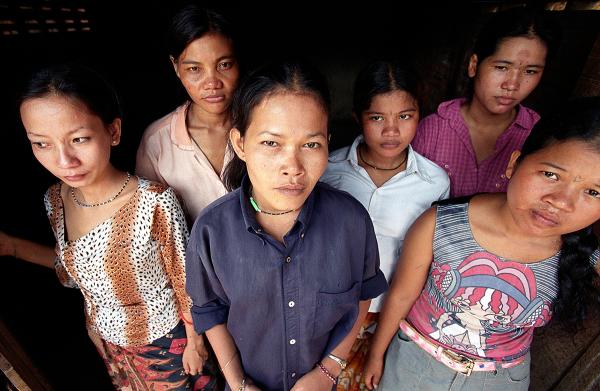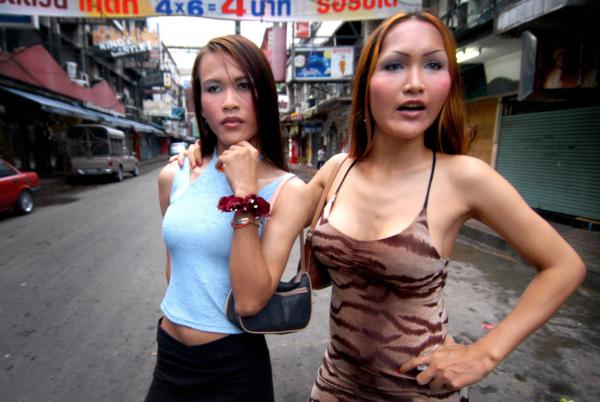This research paper was spurred by analysis by Bob Avakian of major global socio-economic changes and social struggles over the last 50 years influencing shifts in class structure and political-ideological developments, especially the rise of fascism. My particular point of departure is from a section of that broader analysis:
The ruin of much of traditional small-scale farming in the Third World and the dramatic increase of an urban population there (as well as in the U.S. and some other imperialist countries) which in large numbers is unable to find work within the “formal economy”—this has also fostered the growth of an illegal economy and of gangs (and, particularly in Third World countries, cartels) based on this illegal economy, in particular the drug trade but also the trafficking of human beings, especially women and girls viciously victimized in prostitution, the “sex industry,” and literal sexual slavery. [emphasis added]1
This paper examines the dimensions of, and explores key dynamics and historical factors driving, the global growth of prostitution and trafficking of women into prostitution.
I. INTRODUCTION: A NOTE OF CLARIFICATION
The commercial sexual exploitation of women (and of young girls and boys) has reached massive proportions. What is euphemistically referred to as the “global sex industry,” or the “global sex trade,” has evolved into a hugely profitable segment of individual national economies and the world imperialist economy taken as a whole. The “sex industry” encompasses brothel, street, and escort prostitution; strip clubs and massage parlors; pornography; military prostitution; and global “sex tourism” sites. The term sexual exploitation applies to the spectrum of activities ranging from the “self-employed” and remunerated “sex worker” to a kidnapped child trafficked across borders to become a sex slave in a brothel.
In this increasingly integrated and unequal imperialist world economy, women from impoverished Third World countries are lured and trafficked to rich imperialist countries; sold off or kidnapped into sexual exploitation by militaries and gangs; or, as a consequence of the oppressive and distorted workings of imperialist-dominated development, drawn into prostitution as survival strategy.
The scale and horror of this sexual exploitation is veiled by two major factors, one material and the other cultural-ideological.
In the first instance are the complex and overlapping licit and illicit vehicles of supply, marketing, and monetization of globalized sexual exploitation: Internet payment mechanisms; foreign currency flowing to governments of the global South from overseas “sex workers”; telecommunications companies that provide pornography “entertainment”; an international “hotel leisure” industry bound up with expanding “sex tourism” and the airline companies that transport these tourists; banks that lend capital to these sectors; smugglers whose “cargo” simultaneously serves global cheap-labor supply chains and commercial sexual exploitation.
At the same time, and this is the second factor veiling this exploitation, the sexual degradation and violent subordination of women has become increasingly normalized as a given of contemporary economic life and culture: as fashion, as lucrative pornography, as “sex education,” as employment. And in the realm of political-intellectual discourse, sexual subjugation has been poisonously rationalized as an expression of individual “choice” and “agency” on the part of women. Rape, sexual coercion, and sexual humiliation are folded into and masked by the occupational category of “sex work.”
This paper proceeds from the understanding that “sex work”—whether reported/self-reported as “consensual” or “non-consensual”—is, in its essence, the marketed degradation and organized sexual submission of women to male domination. The paper demonstrates why this is the reality, and in the course of the analysis briefly addresses why the concept of “sex work” is profoundly and obscenely misleading and harmful.
(See more photos)
II. CRUCIAL FACTS ABOUT GLOBAL COMMERCIAL SEXUAL EXPLOITATION
*By recent estimates, there are 40-42 million prostitutes worldwide, 75 percent of whom are 13 to 25 years old.2 Sex trafficking is essential in supplying women for national and international commercial sexual exploitation. International sex trafficking refers to the enslavement of persons by means of abduction, force, coercion, fraud, or deception—and the transport of individuals across the borders of one or more countries.
The “industrialization of prostitution” refers to the condition that this exploitation has become large scale, organized, and concentrated (both through legal and criminal enterprise), and subject to widespread global diffusion.3 Imperialist globalization with its pervasive “commodification of everything”—of people, things, nature, and ideas—has been a catalyst for global trafficking in human beings...who are priced, shipped, and sold.
One can speak, both in the language of scientific political economy and in scarifying metaphor, of a “supply chain” of women and children for sexual exploitation and enslavement.
*By the 1990s, commercial sexual exploitation was accounting for anywhere from 2 to 14 percent of the national income of the Philippines, Malaysia, Thailand, and Indonesia.4 In Thailand in the 1990s, it was estimated that 200,000 to 800,000 prostitutes were under 18.5 (Owing to the “officially” illegal status of prostitution in most of the world, and its many, often brutally disguised forms, data is by its nature limited.)
*By 2000, there were an estimated four to six million prostitutes in China, up from some 25,000 in 1985.6 The overthrow of socialism and restoration of capitalism in China in 1976 and the ensuing capitalist restructuring of China’s countryside led to economic and social polarization in China’s rural areas, with heavy burdens placed on women. This upheaval also contributed to history’s largest migration from countryside to city. Prostitution in China has been heavily concentrated in the rapidly growing coastal areas; and female migrants from the rural areas are a major supply source for sexual exploitation.
*Some 70 percent of sex-trafficking victims worldwide are in Asia. The leading countries are India, China, Pakistan, Thailand, and Bangladesh.7
*The 1990-91 collapse of the economies of the former Soviet (social-imperialist) bloc resulted in a major new source of desperate women seeking employment...and becoming prey to international traffickers. Between 1991 and 1998, some 500,000 Ukrainian women had been trafficked to Western countries for sexual exploitation.8
*In Western Europe, even before the more recent wave of mass migrations, an estimated 65 percent of prostitutes were migrants—many from Africa and Central and Eastern Europe.9 Nigeria and Ghana are two of the major African countries from which young women and teenagers are trafficked to Europe for sexual exploitation. Sold many times over, bid upon at auctions, “prepped” in training camps, physically and psychologically broken, they are reduced to the level of slaves: the property of a third party and controlled by a pimp.
*In 2016, the total number of detected victims of modern slavery/human trafficking was estimated to be over 40 million people, some 70 percent of whom are women and girls. Some 25 million are trafficked into forced labor and 15 million into forced marriage. Within the category of forced labor, some five million human beings, 99 percent of them women and children, are trafficked (forced) into sexual exploitation, over one million of whom are children.10 Human trafficking is recruitment, transfer, transport, and harboring or receipt of human beings—through force, fraud, or deception—for the aim and purpose of exploitation for profit.
NOTE: The particular conditions facing transgender and gender non-conforming people in the imperialist and Third World countries in relation to their vulnerability to sex trafficking and physical-sexual violence will be addressed in future analysis.
*Human trafficking, measured by revenue, is the world’s third largest criminal activity (after illegal drugs and counterfeiting).11
*Sex trafficking is immensely profitable. Forced sexual exploitation was generating $99 billion annually by the beginning of the 2010s.12 A scholar who is an advisor to the UN on modern slavery estimated, in a 2019 interview in the British Observer, that the “return on investment for sex trafficking” (an enraging investigate pursuit with enraging metrics) is around 1,000%, as compared with “lower returns on exploitation” for labor trafficked into construction, agriculture, or mining. Such profitability is bound up with “the fact that the victim can be sold up to 20 times a day, generating tens of thousands, if not hundreds of thousands, of dollars in profit per victim.”13
*An estimated 9,000 illicit spas were operating in the U.S. in 2018.The $2.5 billion illicit massage parlor “industry” has been growing rapidly in the U.S.14 It is a major source of “demand” for trafficked women and girls, both from within the U.S. and globally. The total number of trafficked victims into the U.S. is not reliably known. Some estimates suggest that 50,000 women and children from Asia, Latin America, and Eastern Europe are brought to the U.S. each year and forced to work as servants or prostitutes.15 With regard to illegal massage parlors, the majority of trafficking victims who have been reported are from China and South Korea.16 Young girls from the U.S., often running away from abusive parents and relatives, get trapped into trafficking networks.
(See more photos)
III. A FIRST LOOK INTO ECONOMIC-SOCIAL FACTORS DRIVING MARGINALIZATION AND DESPERATION OF WOMEN IN THE THIRD WORLD

Ugandan women who were stopped at Nairobi airport in Kenya because they lacked proper employment papers. They were victims of a human trafficking ring in East Africa. Photo: Institute for Security Studies
The sexual subjugation of women is an historical and structural feature of exploitative, class-divided, patriarchal society. The particular forms of this subordination of women and its concrete manifestations in a gendered division of labor are rooted in the dominant mode of production interacting with tradition, culture, law, and the patriarchal family.
The contemporary “global sex industry” cannot be comprehended simply or mainly as the continuation of the “ages-old practice” of prostitution within modern patriarchal society. More specifically, this form of sexual subjugation and degradation of women has been profoundly shaped, massively magnified, and globally integrated by the workings of late imperialism as a world system of exploitation in which the division between rich oppressor countries and poor oppressed countries is a defining feature of imperialist accumulation—with its plunder of resources in the Third World, penetration of markets, and super-exploitation of labor—and by social-cultural factors bound up with the world system of capitalism-imperialism.
A) Land Grabbing, Rural Poverty, and Women
The undermining and destruction of traditional subsistence economies in the Third World—where people farm and work to meet family and local survival needs—have had an immense impact on women: as caregivers, as displaced indigenous land-dwellers, as migrants moving from countryside to town, from town to city, from city to city with limited employment opportunities, and entering global migrant streams...willingly under desperate circumstances, or as trafficked victim. The loss of peasant and farmer land has been a major factor.
In the decade 2000-10, more than 81 million acres of land in the global South—roughly equal to the size of Portugal—was sold off to foreign investors, both corporate and state entities.17 This is what has been called “land grabbing.”
Much of this land that has been grabbed (defined as large-scale acquisition) has been turned into industrial-scale plantations producing commercial crops, like palm oil, soy, and other profitable food crops—often for export. Some of these “grabs” are to grow bio-fuels (like sugarcane), or for the purpose of planting trees to serve as lucrative carbon “offsets” (this is a con game that enables imperialist corporations and countries to continue to produce and burn fossil fuels but supposedly “offset” the damage by planting trees in the global South that will absorb carbon). Some of this land grabbing is simply speculative investment to make acquisitions in the expectation of land-price rise.
NOTE: Two-thirds of these agricultural land deals of 2000-2010 occurred in countries experiencing serious food insecurity.18
For most of the second half of the 20th century, investment by governments in the Third World in dams and roads, expansion of industry, and mining-minerals extraction—with financial backing and prodding by the World Bank and International Monetary Fund, which are imperialist-dominated financial institutions—played a leading role in pushing peasants off the land. The more recent juggernaut of land grabbing represents a second wave of mass displacement in the name of “development” in the global South.
Landlessness spreads as many subsistence farmers (growing food for family consumption or products for sale to maintain households) lack legally recognized ownership over (title to) land they have farmed; other peasants and farmers are forcibly evicted with backing from the state. Women have been pushed out of traditional fishing and gathering activities. At the same time, the International Monetary Fund and World Bank advance loans to oppressed countries that generally carry conditions like the redirection of agriculture away from cultivation geared to local subsistence-food needs towards specialty export crops, cut flowers, etc.
All of this has had the effect of further marginalizing rural women economically. And these disruptive economic forces, interacting with preexisting relations of female subordination and new forms of gender discrimination, have put new burdens and pressures on women.19
Rural poverty; agribusiness-led transformation and ruin of smallholder agriculture (about which more in section III); environmental stresses on land, water, and resources; and military conflict have profoundly altered traditional work and family patterns and fueled massive migrations of humanity out of the countryside of the global South.
B) Prostitution and the Informal Urban Economy
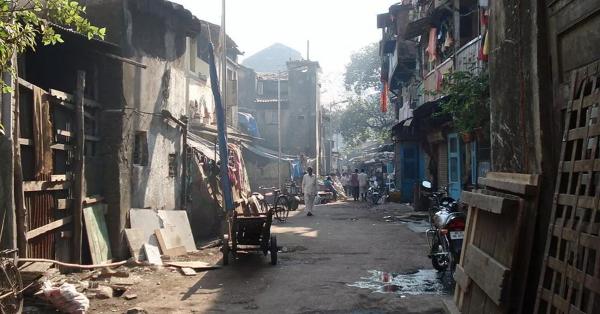
Red light district in Mumbai, India, 2013. Photo: Wikimedia Commons
Prostitution, in its legal and illegal forms, as forced or “voluntary” labor, is an integral element of the global informal economy of unregulated and irregular labor that is the dominant form of employment and survival in the oppressed countries of the global South.
Prostitution is found in shantytowns and informal settlements, alongside factory compounds, agricultural plantations, and around expanding tourism sites (along with tourist guides, drug sellers, street vendors, and others). Foreign mining and logging companies have been known to set up areas of prostitution as a “service” to workers. Special economic (or export-processing) zones servicing foreign capital have been major hubs of prostitution. They are now in some 4,000 locations.20
In Mumbai, India’s second largest city, women migrants from the countryside sell sexual services in brothels and on the street. But another common mode of “exchange” occurs in the informal day-wage labor markets that offer other income-generating activities, like construction and domestic work. The struggle of prostitutes to feed themselves and their families in the cities, and to gain access to shelter and water, takes place in an atmosphere of police persecution and the relentless demolition of squatter settlements.21
C) Migration, Trafficking, and Prostitution

Paramilitary officers in Xiamen in southeastern China detain girls and young women who were among those caught when a smuggling operation into Taiwan was stopped, 2003. Photo: AP/Chinatopix
The uprooting of traditional subsistence economies in the Third World and the “pull” of gainful employment and steady income in particular regions of the world, especially Western Europe and North America, has drawn impoverished labor into migratory streams and human smuggling. Smuggling is not the same as trafficking, which involves entrapment and enslavement, although human smuggling overlaps with trafficking.
Migration across borders has become essential to the survival strategies of women displaced from traditional economies by agribusiness, the climate crisis, regional and local conflicts, and extreme poverty. And these streams of migration “drive up” the supply of “potential sex slaves” to be exploited at low cost.
(Smugglers currently facilitate about 90 percent of the “unofficial” migration to Western Europe and the desperate crossing of borders for safety and a life.)22
Overseas work by Third World migrant laborers also generates “remittances”—a portion of earnings—sent to families back home. These remittances help buoy up economies of the global South. The article "Imperialist Parasitism and Changes in Class-Social Formation in the U.S." details the outsized role that migrant and immigrant laborer remittances play in today’s imperialist world economy—exceeding annual foreign direct investment in the oppressed economies.23
The intense demand and search for cheap labor in and from the oppressed countries of the Third World is a driving force to modern-day human trafficking. This demand for cheap labor has been a major impetus to the operations of criminal syndicates that carry out and “regulate” this trafficking. Indeed, there is no global, imperialist “supply chain” economy without inflows of trafficked labor: in construction, manufacturing, “hospitality,” agriculture, and fishing. “Legal” and “illegal” economic activities are increasingly intertwined in the imperialist world economy.
Think about this vicious cycle in this sphere of sexual exploitation: a woman is recruited in Thailand for overseas work as a domestic; she then gets trafficked to other countries and is coerced into “sex work”...she becomes a slave. Even though most of her prostitution “earnings” are apportioned to a pimp or trafficker, she is able to send some funds home to her family in a rural village. In short, money is cycled back into the Thai economy and helps prop up this economy with, yes, its large “brothel sector” (about which more in section IX).
Such is the matrix of dependent, imperialist-dominated development.
(See more photos)
IV. PULLING THE LENS BACK FURTHER: DISPOSSESSION, EXPULSION, AND A “SURPLUS” POPULATION IN THE THIRD WORLD
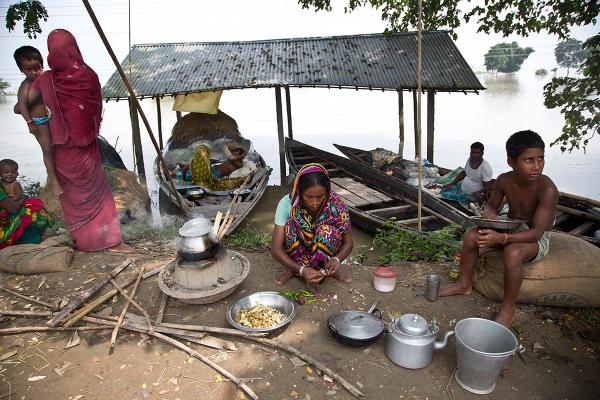
A family takes shelter on a road in Assam, India, after heavy monsoon rains unleashed floods and landslides that displaced millions of people across India, Nepal and Bangladesh, August 15, 2017. Photo: AP
The growth and globalization of the “sex industry” has a pivotal “supply side.” A huge reservoir of displaced and desperate humanity, most especially in the Third World (but not only), is not being absorbed into the structures of the formal economies of the world imperialist system. Formal refers to set pay and hours and some degree of official regulation of working conditions. Rather, vast swaths of oppressed humanity are condemned to precarious modes of survival. Let’s dig deeper.
A) The Separation of Peasant Producers from the Means of Production
Over the last 50 years, a modern-day form of the (often violent) separation of laborers from the means of production has been taking place...devastating the lives of hundreds of millions of rural dwellers in the Third World.
This process of dispossession has been linked to an historically unprecedented process of breakneck and chaotic urbanization in the Third World and the emergence of “mega-cities,” with massive slums and surrounding corridors of squatter settlements inhabited by migrants from the countryside.
What is meant by the “separation of laborers from the means of production”?
*The laborers in question are largely smallholder peasants or farmers who own or rent small plots of land—or who use parcels of community, or what is called “customary,” property.
*The principal means of production that peasant-farmers are being separated from (stripped of) is land, along with associated tools, and access to water.
How are laborers separated from the means of production? The process of separation involves a complex combination of factors:
- the introduction into the Third World, starting in the 1950s and 1960s, of large-scale, more highly mechanized, technologically advanced agriculture, including new hybrid seed varieties, tied into major national and international channels of marketing, which undermines small producers;
- competition from global, imperialist agribusiness;
- the vast takeover of peasant lands through imperialist and state-sponsored infrastructure development (like construction of dams, roads, and storage facilities for large-scale agricultural production, etc.);
- the “land grabbing” by international private investor groups, foreign governments, and domestic elites that converts local agriculture to industrial-plantation production, like palm oil, and mining operations;
- loss of water rights;
- pressure from, and policies imposed by, international “development” and lending institutions, like the World Bank, that pry open markets to exports from the imperialist countries leading to a situation where, for example, U.S. corn undersells and ruins local Mexican maize production...and loans that require as a condition cutbacks in financial support to small growers from governments;
- the privatization of seed and fertilizer through “intellectual property rights” that bind farmers to imperialist agribusiness.
The dispossession of smallholder peasants and farmers has involved “legal” and illegal methods of land seizure...economic pressure and brute force. Big landowners and local, regional, and national governments in the Third World deploy militaries and militias, gangs and thugs; they create formal titles to ownership that provide legal cover for the purchase or forcible takeover of land held and farmed by local peasant populations and for generations by tribal and indigenous peoples, but without formal private title. At the same time, competition among farmer-peasants results in some gaining advantage in productivity, size of landholdings, ability to hire laborers.
Here is a revealing statistic: As late as 1983, the majority of the world’s workers were still in agriculture (overwhelmingly in the global South). But by the start of the 2010s, only 25 percent of the world’s workers were in agriculture.24
Here is the ongoing reality for the displaced of the global South: new jobs outside of agriculture are not being created anywhere on the scale to absorb those being separated from the land.
B) Not the Same as What Happened During the Industrial Revolution of the 1700s and 1800s
This process of separation of laborers from the means of production has not been a simple retracing of the experience of the driving of peasants from the land as occurred over several centuries in Europe, and the explosive unfolding of the Industrial Revolution, centered in England, in the late 18th and 19th centuries. At that time, a process of labor-intensive capitalist industrialization was taking place. Capitalist production was stimulating the growth of a new agricultural and industrial proletariat drawn from the countryside. And mass factory production, like the cotton mills of England, with all the horrific conditions, was absorbing new proletarians in great numbers.
But under conditions of imperialist domination today, economic development in the oppressed countries of the global South is both subordinated to and distorted by the needs of imperialism and highly vulnerable to (tied to) the ups and downs of the world imperialist economy. These countries are not “reenacting” the earlier Industrial Revolution, which itself was inseparable from the global slave trade and colonial conquest, whose consequences are still felt in the oppressed countries.
In today’s world-capitalist economy, the dispossessed and uprooted peasants of the Third World are not in their great numbers being incorporated into industrial mass systems of production. Those leaving agriculture—whether forced out or “choosing” to leave under oppressive conditions—are not in their great numbers finding standardized industrial and service jobs. They become a surplus population. A “surplus” not in the sense of “over-population” due to high birth rates or absolute shortage of resources—but a “surplus humanity” relative to capitalism’s demand for labor to serve profit-based production.
Significantly, over the last 40 years there has been a great expansion of manufacturing production in the Third World. This is very much linked to foreign investment and outsourcing of production from the capitalist-imperialist countries. This is a defining feature of the contemporary world-imperialist economy and essential to the profitability of imperialist capital. But new, mass manufacturing capacity in the Third World is largely concentrated in a cluster of countries. Imperialist investment and outsourcing, along with the expansion of local manufacturing-industrial capacity, have not generated employment for the great bulk of the newly urbanized populations of the Third World.25
Here is the historical trend: Throughout most of the global South, the large-scale movement of rural dwellers to cities has not been a large-scale movement into industry and services in the formal economy with set hours, wages, and operating within a certain legal framework.*
Almost 70 percent of employment in low- and middle-income regions of the world is in the informal economy of irregular and insecure (often temporary) jobs, much of which is self-employment or daily labor hire—with no set hours or wages, or safety and health protections or other official regulations. The occupations include street vendors, construction laborers, myriad service jobs (repairing cell phones), domestic workers, rag and waste pickers, and overlap with illegal activities like trade in counterfeit goods. In India, 80 percent of employment outside of agriculture is informal—and in Africa, 85 percent of non-agricultural employment is informal. Over 90 percent of the world’s informal labor force is in the global South.27
C) Displacement and Expulsion
In Expulsions: Brutality and Complexity in the Global Economy, Saskia Sassen develops an analysis of a transition on a world scale from capitalist-imperialist development “incorporating” masses of the poor and uprooted into economic activity...to one, accelerating at the end of the 20th century and continuing into the 21st century, characterized by the massive “expelling” of people from land, employment, and home.
Sassen sees a global dynamic linking:
displaced persons [in the Third World] who will never go back home—home is now a war zone, a plantation, a mining operation, or dead land... [and] an equivalent shift in the global North, where what until recently was incarceration as response to a crime (whether the crime was actually committed or not) is now becoming the warehousing of people [mass incarceration]...with the United States in a vanguard all its own.
She goes on to observe, and this is particularly relevant to the focus of this paper, that:
expulsions from home, land, and job have also had the effect of giving expanding operational space to criminal networks and to the trafficking of people, as well as greater access to land and underground water resources to foreign buyers, whether firms or governments.28 (Sassen’s talk at Revolution Books on Expulsions is at: https://vimeo.com/108811541)
D) Planet of Slums
This is the title of a book by Mike Davis that provides vital analysis for understanding the phenomena under discussion. The closing chapter begins with an evocative passage from the novel Texaco by Patrick Chamoiseau: “A proletariat without factories, workshops, and work, and without bosses, in the muddle of odd jobs, drowning in survival and leading an existence like a path through embers.” The “muddle of odd jobs” is the “informal economy.” Texaco is the name of the squatter settlement in the capital city of the Caribbean island of Martinique.29
The ferocity, speed, and pain of what is happening cannot be overstated. The proportion of the world’s population living in cities rose from 34 percent in 1960 to 47 percent in 2000 to 56 percent in 2018. Over 75 percent of the world’s urban population lives in the cities of the global South. By 2015, 40 percent of the world’s urban expansion was taking place in slums; in sub-Saharan Africa, over 60 percent of the population lives in slums. In 2019, over 1 billion people, or almost 1 in 7 on the planet, were living in urban slums and so-called “informal settlements” that ring urban areas—with poor sanitation, contaminated water, few health services—overwhelmingly in and surrounding mega-cities of the global South.30
This rural to urban migration of the displaced...this migration that often continues from one Third World country to another...and to the imperialist countries—this has everything to do with the globalization of prostitution.
E) And Global Warming
Economy, society, politics, and the revolution for a radically different and far better world are inextricably bound up with the planetary environmental crisis. Global warming is having disproportionate effects on agriculture in the Third World—drought and desertification. It intensifies environmental stresses in the cities, slums, and squatting settlements of the global South. It compounds the dynamics of expulsion, mass migrations, and the emergence of a “surplus humanity.”
(See more photos)
V. WE CONTINUE BY LISTENING TO AYE’S AND MARY’S ACCOUNTS OF THEIR DESCENT INTO HELL...AND THE NIGHTMARE FACING ROHINGYA REFUGEES

This 17-year-old refugee woman of the Rohingya ethnic minority escaped genocidal assault in Myanmar only to be trafficked to one of Bangladesh's so-called “brothel villages" from which she fled by boat. Photo: AP
▸ Aye was only 14 when a woman approached her family in Myanmar. She told them that Aye could work in Bangkok. Living in extreme poverty, Aye’s parents gave her and her sister permission to travel to Thailand to take advantage of the work opportunity. Upon arriving, they were immediately handed over to a group of men who sold them to a brothel owner.
Aye’s parents didn’t hear from her for three years...until she was found during a brothel raid. She had been held captive on the fifth floor of the brothel, along with 100 other women: required to work from noon to two in the morning, forced to service 12 to 20 men daily. Each girl was given a shirt with a number attached to it; they would watch TV while waiting for their number to be called. A glass wall separated the women and girls from men until he paid the $6.00 charge to spend 30 minutes with the girl of his choice. The women and girls received a dollar a day for their “work.”31
▸ Mary was a promising high school student from the Nigerian state of Edo. She dreamed of going to the university. She was 16 when a woman approached her mother and offered to take the teenager to Italy to find work. Mary’s family pushed her to accept the offer, hoping this would help lift them out of poverty. Mary ended up being trafficked into prostitution: three years in which she was forced into selling her body, endured beatings and threats at gunpoint, and forced to watch the brutal degradation (carrots violently inserted into the vaginas) of even younger girls as an object lesson for what would happen if she resisted.
Mary was finally repatriated to Nigeria after a raid. But Mary’s family shunned her. That was 20 years ago. Today, the situation is far worse. Gangs take advantage of the chaos of the migrant crisis—“selling” more women, and younger and younger girls, into sexual slavery. She reflected that these young girls now have more knowledge of what they are getting into than she did...but they don’t know the trauma they will suffer if they ever get out of it like she did.32
▸ A young Rohingya refugee fleeing Myanmar crosses over to neighboring Malaysia. She is among the hundreds of thousands who have been persecuted, demonized, and expelled from Myanmar. In a camp just inside Malaysia, she and other girls are initially sold into a forced marriage. But then after a certain period of time, their “husbands” sell the girls to other men. Some end up as domestic workers or bonded laborers. Traffickers promising them higher wages lure some of these teenagers and young women into forced prostitution. Other Rohingya women are press-ganged into Thailand’s seafood industry. The industry is highly dependent on cheap and slave labor, and is one in which women are exposed to life-threatening work conditions and sexually abusive treatment. The industry serves the U.S. retail food sector.
Other refugees wind up in Bangladesh, now the main destination for the Rohingya—with some one million living there, including hundreds of thousands who fled in previous decades. Their stateless status and inability to find work legally makes women and girls especially vulnerable to sex trafficking. Some will wind up in one of Bangladesh’s so-called “brothel villages”—where they join Bangladeshi women and teenagers, some as young as 13.
Prostitution is legal in Bangladesh. The steady stream of trafficked women and children into the prostitution industry makes girls disposable to those making money out of them. Some of the young women become so despondent that they cannot continue—they cut themselves, they commit suicide (one a month) in the country’s largest brothel village. The women are forbidden from burying the dead in public cemeteries, so these prostitutes have built private graveyards to cope with the situation...and conduct makeshift funerals. 33
As imperialist globalization deepens, new sex trafficking routes emerge: Mexican women to U.S.-Mexico border towns; Nepalese girls to India; Nigerian women to Italy; Asian women to Australian mining towns.
(See more photos)
VI. A NOTE ON RATIONALIZATIONS OF “SEX WORK” AND THE DESCENT INTO HELL

Young woman from Bangladesh who was trafficked when she was 9 years old and sold to a brothel when she was 13.
It must be clearly understood and stated that “sex work,” as against its many rationalizations, including those emanating from certain currents of feminism and “woke” identity politics, is not simply “work” of a special kind. It is not just a more heinous form of “trade.” Trafficking for prostitution is not some variant of “migration for labor.” Not when what is actually done to the bodies of women, including being forced and initiated into prostitution through rape and gang rape by pimps and traffickers, with all the attendant physical and psychological effects, is taken into account. Being trafficked for prostitution is “the experience of being sexually used by many men daily, unable to refuse any practice or any male, while under the control of overseers and receiving no payment until a putative debt, made up by the trafficker and added to daily for personal items, is paid off.”34 And there is, among the proponents of the “sex work” paradigm for global prostitution, an imperio-chauvinist blind spot: a refusal to reckon with the horrors of this in the Third World.
It is often argued in defense of “sex work” that, yes, it can be degrading...but so too are all manner of jobs under capitalism. In answering this, revcom.us published an article that points to the problem with this argument:
It is definitely true that there are many jobs in this world which are truly degrading and highly exploitative. This is a big part of why we need a revolution; it is utterly insane and unnecessary for so many people’s lives to be squandered in this way…. On the other hand, when a man purchases a woman or very young girl in prostitution or pornography... it is her sexual enslavement and degradation that is being purchased... He is paying for the experience of being able to disrespect, violate, beat, insult, and humiliate a woman. [emphasis added]35
Another line of argument by advocates of “sex work” is that the transaction through which a woman exchanges her body to men for purposes of sexual pleasure—whether as street prostitute, “high-end” escort, performer—is actually a form of female “agency”...of “choice” in a world of globalized commerce and self-promotion. In this view, the operative fact is that a conscious choice is being made. This is a species of delusion and self-delusion.
As this analysis has demonstrated, larger economic-social forces set and delimit the range of “choices” afforded women, especially impoverished and uprooted women on the planet. The workings of imperialist accumulation and the social fabric of patriarchy condition these choices. And as Bob Avakian powerfully explains in the article “On Choices...And Radical Changes,” people make choices, but that “doesn’t mean that they chose to have those choices.”36
An essay rebuking “choice-based” rationalizations of “sex work” makes the important point that prostitution is “created by a relation and not by individual willingness... [that is,] without male sex buyer and prostituted woman, there is no prostitution.”37
The recognition of the intrinsically oppressive nature of prostitution, and uniting with the just demand for the decriminalization of prostitutes, is not, however, the end of the matter...
The sexual exploitation and oppression of women must and can, and can only, be ended through the communist revolution to overthrow this system and uproot all exploitation and oppression. Put differently, the conscious and collective making and carrying forward of this revolution to radically rupture with all traditional property relations and all traditional ideas and values is “agency,” liberatory agency, writ large.
(See more photos)
VII. SEX TRAFFICKING AS A CRITICAL COMPONENT OF THE GLOBAL ILLICIT ECONOMY THAT HAS BOOMED IN THE LAST 20 YEARS
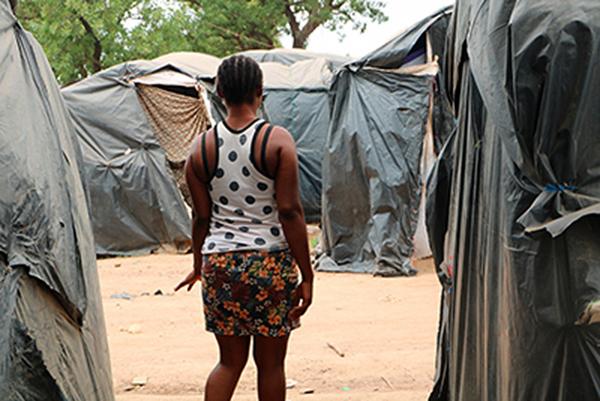
A Nigerian woman trafficked to Burkina Faso and forced into prostitution in the gold mining town of Secaco walks through a tent encampment where she and others like her live and are forced to have sex with up to 30 men per night. Photo: AP/Sam Mednick
We turn to a critical point of analysis: imperialist globalization has facilitated a kind of “global architecture” that not only intertwines legal and illegal global labor supply networks but also blurs the distinctions between them. In any number of legal industries, illicit economies circulate around and into them: including fishing, cobalt, gold mining, and the timber trade. In the realm of finance, “legitimate” banking bleeds into “shadow” banking and money laundering.
The global illicit economy is valued at $2.2 trillion.38
As the study The Global Illicit Economy: Trajectories of Transnational Organized Crime puts it: “The opaque global banking system that developed at the start of the new millennium has allowed legal and illegal profits to come together to create billion-dollar reservoirs of untouchable assets, while reinforcing the power and influence of the actors who utilize them.”39 And the tools of digital technology and digital commerce have served at once to bolster and camouflage illicit micro-activities and illicit economies of scale—drugs, weapons, human trafficking. Payments to traffickers can be conducted without trace of transaction.
All of this has been exacerbated by the COVID-19 pandemic:
Decades of globalization and trade liberalization have created massive disparities in wealth and power. Before the coronavirus pandemic, opportunities for working in the legal economy were already diminishing. As a result of the pandemic, the situation has become even worse, especially for those working in the informal economy...These conditions create space for illicit economies to expand and offer services and employ (often coercively) an increasing number of people.40
As discussed earlier, the chaotic urbanizing trends of Third World economic development under imperialist domination interact with the inability of the formal economy to provide employment. In the slums and informal urban settlements, the state is not able to provide governance, services, and safety. Demand for water, and charcoal to heat homes and for use as cooking fuel, and other essential requirements, cannot be met in the unregulated economic atmosphere. Into this vacuum, criminal groups and local gangs often step—and increasingly co-opt unregulated markets. In some cases during the COVID-19 pandemic, gangs have been enforcing health quarantines.
The underground illicit economy grows and provides that “alternative space” for employment and income generation. Prostitution is a major component of this burgeoning “alternative” economy. The gangs and criminal groups, drawing in youth and the extremely marginalized, multiply and branch out to other activities—interweaving with traffickers and migrant smugglers, and with the global “sex industry.”
VIII. SEX, MAIDS, AND EXPORT PROCESSING...AND THE RISE OF “SEX TOURISM”
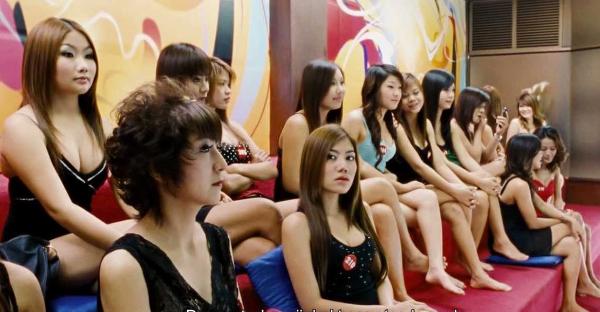
Women at a brothel in Macao, China—a big center for “sex tourism,” promoted as the “Las Vegas of the East.”
A) The Movement of Women in the Third World Into and Out of the Formal Economy
A 2001 research essay, Sex, Maids, and Export Processing: Risks and Reasons for Gendered Global Production Networks, explores how, over the preceding three decades, great numbers of women in the Third World have been drawn into the three named sectors of the study's title...and moved among them.41
Imperialist outsourcing of production has stimulated the growth of export-processing zones, which depend for profitability and competitiveness on women as superexploitable workers. Yet, the “race to the bottom”—imperialism’s ever-intensifying search for cheaper labor—results in the constant, competitive shifting and relocation of production. A first wave of outsourced garment and other consumer goods manufacturing in Taiwan, South Korea, Singapore, etc., gave way to a second wave focused in other areas, like Bangladesh and China—and led to the shuttering of many of these factories.
Outsourced/subcontracted factory employment is at once grueling and tenuous. This heightens the vulnerability of women workers and their families. At the same time, the imposition by imperialist financial institutions of austerity and structural adjustment, beginning in the 1980s and continuing in various forms to today—with resulting cutbacks in and privatization of basic services—exerts greater pressure on women to scrape together means to maintain households.
Some of these women in factories return to the household or informal sectors of work, including domestic service and prostitution—or migrate to join these sectors abroad. But once they become prostitutes, many women find themselves trapped...forced to stay in this work owing to stigma, debts accumulated to “sponsors” (often traffickers), and criminal organizations that prevent them from escaping this condition.
B) The Case of Dongguan in China
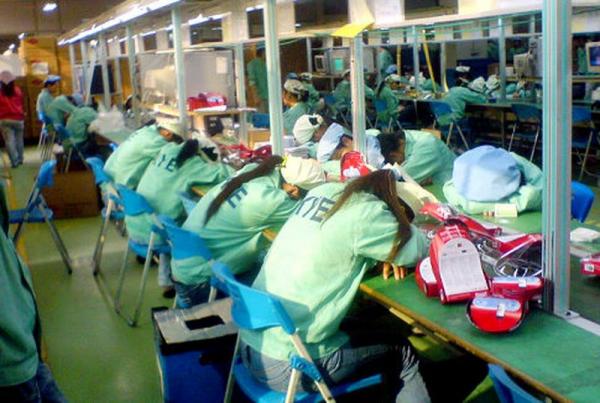
Women workers, exhausted at their work stations, at a factory in Dongguan, China, that makes webcams and other equipment for Microsoft. Photo: The National Labor Committee
The city of Dongguan is in the heart of the Pearl River Delta, the massive export-manufacturing zone on China’s southern coast adjacent Hong Kong. In the first decade of this century, Dongguan became known as the “Amsterdam of the East” with some 300,000 prostitutes in the city. Though officially illegal, by some estimates, prostitution accounted for 10 percent of the city’s revenues and employment.
The role of internal migrant labor was critical. Hundreds of thousands of women from the poor rural interior of China had flocked to the coast for better-paying jobs in the cheap-labor manufacturing sweatshops in rapidly growing cities like Dongguan. Some 90 percent of Dongguan’s prostitutes had originally sought work in these factories, but either could not get those jobs or found that these jobs were not what these women were told they would be.42
Prostitution became the job of opportunity and compulsion under such circumstances. These “sex workers” were in demand from male migrant workers who had also come from the interior, though in far greater numbers than women; and these prostitutes were in demand from businessmen who came to this coastal city to conduct commerce.
As China’s export boom slowed on account of the 2007-09 global recession and as China moved into more advanced manufacturing that was less labor-intensive—and with employment opportunities for women contracting—more women sought work as prostitutes. Brothel owners and traffickers had a growing reservoir of desperate women to lure and deceive. The government launched crackdowns, but the industry did not disappear; it simply changed its methods of operation...and Dongguan remains China’s “sin city” in the exultant language of online “sex tourist” guides.
C) Global “Sex Tourism” and the Formative Role of the Genocidal U.S. Military

A U.S. GI walking past a brothel in South Vietnam during the Vietnam War. During 10 years of America’s genocidal war in Vietnam (1965-75), between 400,000 and 500,000 Vietnamese women and girls became prostitutes.
From the aptly and provocatively titled book and extremely valuable analysis by Sheila Jeffreys, The Industrial Vagina: The Political Economy of the Global Sex Trade:
Military prostitution was a most important vector in the globalization and industrialization of prostitution in the late 20th century. The massive industrialized militaries of the 20th century understood that prostitution was necessary for their military preparedness...Military prostitution on a scale similar to that employed by the Japanese [mass prostitution and sexual enslavement of women in the countries and territories occupied by Japanese imperialism in the 1930s and 1940s] was part of the U.S. military rest and recreation regimes after World War 2 throughout South East Asia. They formed the basis for the huge sex industries and trafficking of women that developed in Korea, Thailand, and the Philippines, and became such important sectors of their economies. In its sheer scale, military prostitution can be seen as kick-starting a crucial aspect of the globalization of prostitution, the sexual exploitation of a sexual proletariat of women and children from poor countries by members of rich westernized nations....After military prostitution caused the industrialization of prostitution in a country, local women and girls became the raw materials of the global sex industry, not only prostituted within local and sex tourism industries at home but trafficked into prostitution worldwide.43
The American Crime series at revcom.us has an installment, “America’s War in Vietnam and the Sexual Subjugation of Women,” which documents the forging of a “huge brothel economy” in South Vietnam. In the ten years (1965-75) of America’s genocidal war, some 400,000-500,000 Vietnamese women and girls became prostitutes.44
Sexual exploitation to service U.S. soldiers became more organized, “industrialized,” as it was spread to Thailand. This was enshrined in a pact between the U.S. and Thailand engineered by Defense Secretary Robert McNamara in 1967. In exchange for economic aid, the Thai government agreed to provide sexual R&R (“rest and recreation”) for American soldiers on temporary leave—thus giving “sex tourism” in Thailand both official sanction and external boost.45 All in a decade’s work of murdering two million Vietnamese!
Sex trafficking during war has remained a “tradition” of the U.S. military: for instance, in the U.S. “green zone” in Baghdad following America’s invasion of Iraq in 2003, women from Belarus, China, and Iran were trafficked by U.S. subcontractors to work as prostitutes.46
At the same time, military prostitution on a mass scale has had its own “multiplier effect.” There is a very definite connection between the “boom” in military prostitution during the Vietnam War, the U.S.’s military bases in East and Southeast Asia, and the subsequent development of “sex tourism” in that region. As Jeffreys writes:
The development of the sex tourism industry in Asia from the 1970s outwards was substantially aided by the groundwork put in place by U.S. military prostitution. It began in the same sites in which prostitution had been developed to service the U.S. military in rest and recreation, such as Thailand, the Philippines, and Korea, and developed to the point where it was providing a substantial proportion of GDP in those countries. Indeed, the governments of poor countries have deliberately developed sex tourism as a means to gain foreign exchange...
Prostitution tourism has not just developed in countries and sites in Asia that harbored military prostitution. It is a developing part of the prostitution industry in all those areas where men as individuals or in groups travel for fun, on business, for sports events or political assemblies. They may be tourists visiting specially for the purpose of prostituting women, or to use casinos since prostitution use is integrally connected with this activity, or visiting businessmen, or male sports enthusiasts who prostitute women as an ordinary part of the traveling experience. There are prostitution tourism destinations in the rich world, such as Amsterdam and the U.S. state of Nevada. There are poor countries too that have used prostitution tourism as a tool to develop their economies and place local women in the marketplace as a resource to be exploited, without having profound experiences of military prostitution, such as Jamaica.47
Indeed, in the late 1970s, Jamaica received loans from the International Monetary Fund, loans in exchange for “policy reforms.” Those “reforms” required that the Jamaican economy be redirected towards the needs of the imperialist world market. This came first with a push towards export-led manufacturing. That short-lived initiative collapsed in the face of competition from even cheaper zones of production. What followed was the promotion of tourism—the “commodification of paradise” in the Caribbean and Southeast Asia—with the “exotic” and “submissive” female body on offer.
Jamaican-born writer Nicole Dennis-Benn (who spoke at Revolution Books) captures some of the human consequences in her 2016 novel Here Comes the Sun. In commentary on the novel and the choices made by its characters, she has pointed out:
Upward mobility in Jamaica is extremely difficult, which is why a lot of working-class Jamaicans leave. But those who stay have to find ways to make ends meet. In my novel, Margot had to supplement her meager salary as a hotel clerk with prostitution. In a country like Jamaica where tourism is our number one revenue, our disenfranchised population capitalize off that. It’s not like the hotels are using their profits to make things better for us and our society.48
Let’s take this in at a higher level of abstraction. International tourism (with the implicit “attraction” of easy access to commercial sex) has come to be seen by increasing numbers of Third World governments, with the prodding of imperialist investors and international financial institutions, as a form of economic growth, as a “strategic development activity.”
Many young women, excluded from sectors requiring certain skills, along with children facing desperate conditions, seek employment in tourism’s informal sector. And in many oppressed countries, informal sector tourism is inseparable from the “sex trade” industry of women and children. Western capital—hotel chains, airlines, and shipping companies, the list goes on—derives enormous benefits from this major “global industry” that exists and thrives on the sexual subjugation and degradation of women.
“Sex tourism” is a feature of the imperialist countries as well. The “supply chain” (the global “raw material”) for legalized and semi-legal prostitution in these countries centrally involves foreign prostitutes. In the Netherlands, where prostitution is legal and “prostitution tourism” is a major “tourist attraction” in the capital city of Amsterdam, an estimated 60 to 75 percent of the country’s prostitutes are migrants.49
D) Business Prostitution
If prostitution is normalized in the Third World, in the ways analyzed, especially “sex tourism,” it takes on new, ever more normalized dimensions in the venues of deal making and business entertainment in the imperialist countries. From Tokyo to Shanghai, from London to cities in the U.S. like Atlanta (which relies heavily on commercial conventions), “business prostitution” has grown enormously and become more central to “business networking” internationally.
This segment of the “sex industry” comprises overt prostitution, strip clubs, and massage parlors, and global “sex tourism” centers. It functions as a special, exclusionary mode of male bonding in the pursuit of commerce. It embodies and reinforces male privilege at all levels of corporate hierarchy. Various “glass-ceiling" studies point to these disgusting rituals as a major impediment to professional women's ability to gain access to the “informal social networks” necessary for advancing careers.50
(See more photos)
IX. PARASITIC CULTURE, THE VIOLENT REASSERTION OF MALE ENTITLEMENT, AND GLOBALIZED PROSTITUTION
The analysis in this research paper has mainly focused on the “supply (chain) side” of the global “sex industry.” But what of the “demand” side, the (rising) demand for women’s sexual subservience and degradation—and its enactment in myriad forms? What has been influencing and shaping this? It is a question that deserves fuller investigation and deeper synthesis in its own right. What follows are some preliminary reflections and markers for further investigation.
A provocative question is posed by an Australian scholar of globalization and prostitution. She writes:
Poverty, dislocation, and female desperation are routinely cited in explanation of prostitution, as well as the trafficking that organizes the trade...But parallel to these global developments, what has caused growing numbers of men to prostitute women at greater frequency over the past fifty years, if we see the global sex industry as having burgeoned during this period? In other words, what has accelerated demand for prostitution among men...what has caused the fashion to emerge among men that buying sex might be thought reasonable, even desirable?51
We are not, as this scholar correctly points out, dealing with some biological “essentialist” male sex drive, or some “latent prostitution demand” that lies dormant in men. And she is on to something when she observes that the “banal sexual trading of women and children within the context of men’s everyday lives as consumers is a twenty-first century reality that the gendered anti-slavery movements of neither the nineteenth nor twentieth centuries have been able to prevent.”52 Her use of the term “banal” is, of course, to highlight the routinization, that normalization, of sexual exploitation and violence directed at women.
Bob Avakian has provided the analytic tools with which to explore and understand this. He is the architect of the only kind of revolution, a revolution guided by the new communism, through which we can radically transform this. The new communism takes the liberation of women as a central and touchstone question for the revolution in the 21st century to emancipate humanity from all oppression and exploitation.
We live in a world in which “two outmodeds” are clashing with each other: the outmoded economy and culture and ruling strata of the imperialist system; and reactionary fundamentalisms, reflecting the outlook of historically outmoded strata among colonized and oppressed humanity.53 Pornography meets the veil—women’s dehumanization in medieval and modern form.
We live in a world of extreme parasitism and privilege in the imperialist heartlands—of wasteful, toxic, and numbing consumerism, including garish “sex entertainment”; a world of “sex tourism” as “growth industry” in the Third World.
In so many ways, as Avakian has emphasized, underlying economic forces and deep social-cultural changes and struggles have put the patriarchal family, and patriarchal relations in general, under enormous strain.54 Traditional social ties and roles have fractured, both in the imperialist and the oppressed countries. Peasant women have become superexploited wage laborers in garment and electronic factories in Third World export-processing zones. In the U.S., women who in previous generations would have been full-time wives and homemakers now graduate from college in greater numbers than men. Households have changed: dual income, female-headed, alongside cultural challenges to gender traditions.
But these economic and social changes remain contained and constrained within the shell (and armor) of prevailing economic, social, and ideological relations, of the patriarchal organization of society. This applies in distinct but profoundly interrelated ways in both the imperialist and oppressed countries—not least because of the processes of imperialist globalization and its cultural expressions.
In this light, a few additional points of reflection for subsequent investigation:
*“Male revanchism” in response to the undermining and erosion of traditional and formerly stable forms of patriarchal control over women—and a felt “loss of male status” at home, work, and in society at large. Violence against women, including rape and gang rape, plays an integral role in the reassertion of male privilege, entitlement, and standing...and as “punishment” to those threatening it.
*The mass production, spread, and consumption of pornography on a global scale...the huge role of sex trafficking in this global industry...and of pornography in “educating,” socializing, and habituating young boys and men in general to what is acceptable, indeed valued—reinforcing the extreme commodification and objectification of women.
Bob Avakian has drawn a searing parallel between pornography and “postcards of a hanging”—the postcards, with graphic pictures of lynchings of Black men in the early 20th century, that were sold as “souvenirs” of sadistic punishment and mutilation.55 Like those postcards, pornography perpetrates, rationalizes, and delights in violence against real people.
There are multiple research studies showing that pornography is a primary source of information about sex for young people—and that young boys in particular who view internet pornography regard its depiction of sex as “realistic.”56 Never mind consent based on equality, shared affection, and mutual pleasure.
Another salient fact: America has been the leader in the global production, proliferation and global “mainstreaming” of pornography and its dominant tropes: misogyny, sexual violence, racism, and neocolonial sexual conquest. The global pornography industry generates some $97 billion, with the U.S. hosting some 60 percent of the world's pornography websites.57
*The role of the Internet in amplifying the global trade in women and children: for “sex tourism” and sex centers in the U.S. and Western Europe, for “business prostitution,” domestic escort-prostitution agencies, “compensated dating,” etc. Cyber-connectivity has “stimulated” the demand for and access to commercial sex venues. The Internet is in fact the principal means by which pornography is delivered to men, especially in the imperialist countries. And, not least, cyber-technology facilitates prostitution and sex trafficking...and their disguise.
~~~~~~~~~~
The horror, the horror...
Break the chains. Unleash the fury of women as a mighty force for revolution!
Endnotes and Citations
* Taiwan and South Korea are often cited as “miracles of development” and a first wave of “newly industrializing countries” that other Third World countries could emulate. But these are special cases. The economic-industrial development of Taiwan and South Korea after the end of World War 2 in 1945 is inseparable from their strategic role as “frontline” states in the U.S. Cold War confrontation in Asia, especially directed against revolutionary China led by Mao. Taiwan and South Korea were built up as privileged neocolonial “client states” with special access to foreign assistance, loans, investments, and to the U.S. market. They became favored sites of industrial investment-relocation by U.S. and Japanese transnational firms. And this high-speed economic-industrial development pivoted on savage repression carried out by these client states against their populations.26 [back]
1. “NEW YEAR’S STATEMENT BY BOB AVAKIAN: A New Year, The Urgent Need For A Radically New World—For The Emancipation Of All Humanity, January 2021,” www.revcom.us, Emphasis added. For further understanding of the dynamics of capitalism-imperialism and the need and basis for revolution, see Bob Avakian, “Commodities & Capitalism—And the Terrible Consequences of this System: A Basic Explanation”; Bob Avakian, “Why The World Is So Messed Up, And What Can Be Done to Radically Change This—A Basic Scientific Understanding”; and Raymond Lotta, “Imperialist Parasitism and Class-Social Recomposition in the U.S. From the 1970s to Today: An Exploration of Trends and Changes.” All available at revcom.us. [back]
2. This 40-42 million estimate appears in the comprehensive studies of global prostitution produced by the Paris-based Scelles Foundation; Catherine Goldmann, Current Assessment of the State of Prostitution, 2013 (Paris: Scelles Foundation), p. 5. [back]
3. An early theorization of global prostitution as subject to forces of “industrialization” is found in Kathleen Barry, The Prostitution of Sexuality (New York: NYU Press, 1996). [back]
4. International Labor Organization, “Sex Industry Assuming Massive Proportions in Southeast Asia,” Press Release, August 19, 1998. [back]
5. Brian M. Willis, Barry S. Levy, "Child prostitution: global health burden, research needs, and interventions," The Lancet, Vol 359, April 20, 2002, p. 1417; Patricia D. Levan, “Curtailing Thailand's Child Prostitution Through an International Conscience,” American University International Law Review, Vol. 9, No. 3 (1994), pp. 869-70. In 2007, some 40 percent of Thailand's prostitutes were estimated to be under 18—see Ecpat, Global Monitoring Status of Action against Commercial Sexual Exploitation of Children, Country report of Thailand, 2011, p, 13. Willis and Levy cite studies estimating child prostitution in Brazil in the range of 100,000-500,000 at the turn of this century. [back]
6. HIV and AIDS Data Hub for Asia-Pacific, China: Sex Work and HIV/AIDS, 2010, Table 1, p. 2. [back]
7. International Labor Organization, Global Estimates of Modern Slavery: Forced Labor and Forced Marriage (Geneva: 2017). [back]
8. International Organization for Migration, Information Campaign Against Trafficking in Women from Ukraine-Research Report (Geneva: 1998). [back]
9. PICUM, Safeguarding the Human Rights and Dignity of Undocumented Migrant Sex Workers (Brussels: 2019), p. 9. [back]
10. Global Estimates of Modern Slavery, pp. 9-11; more data and analysis is found in UN Office on Drugs and Crime, “Executive Summary,” Global Report on Trafficking in Persons, 2020 (New York: 2020), [back]
11. Channing May, Transnational Crime and the Developing World (Washington, D.C.: Global Financial Integrity, 2017), Table X1. [back]
12. International Labor Organization, Profits and Poverty: The Economics of Forced Labor (Geneva: 2014), Table 2.1, p. 13. [back]
13. Cited in Corinne Redfern, “The Living Hell of Young Girls Enslaved in Bangladesh’s Brothels,” Guardian, July 6, 2019; see also, Siddharth Kara, Modern Slavery: A Global Perspective (New York: Columbia University Press, 2017). [back]
14. Polaris Project, “Hidden in Plain Sight: How Corporate Secrecy Facilitates Human Trafficking in Illegal Massage Parlors,” April 2018, p. 1. [back]
15. Cesar Chelala, “Child Trafficking: A Global Scourge,” The Globalist, July 16, 2019. [back]
16. Cara Kelly, “13 Sex traffficking statistics that explain the enormity of the global sex trade,” USA Today, July 30, 2019. [back]
17. Kate Geary, Our Land Our Lives: Time Out on the Global Land Rush, (Oxford, UK: Oxfam International, 2013). The small-farmer advocacy organization GRAIN.org maintains a data base of global landgrabbing. See also, Saskia Sassen, Expulsions: Complexity and Brutality in the World Economy (Cambridge: Belnap Press, 2014), chapter 2, “The New Global Market for Land.” Analysis of land dispossession, resistance, and conflict is found in The Journal of Peasant Studies, including the special issue “The New Enclosures: Critical Perspectives on Corporate Land Deals” (Vol. 39, Issue 3-4, 2012) with articles on landgrabbing in Africa; and the special issue "Rural Land Dispossession in China and India” (Vol. 47, No. 6, 2020). On Thailand, Cambodia, and Myanmar, see Local Act Thailand, “Land Grabbing and Impacts to Small-Scale Farmers in Southeast Asia Sub-Region,” (April 2015). [back]
18. Geary, Our Land Our Lives. [back]
19. See, for instance, Michael Levien, Gender and Land Dispossession: A Comparative Analysis, (New York: UN Women, 2017). [back]
20. UNCTAD, Enhancing the Contribution of Export-Processing Zones to the Sustainable Development Goals (New York: United Nations Publications, 2015), Preface. [back]
21. For a street-level, investigative study, see Svati P. Shah, Street Corner Secrets: Sex, Work and Migration in the City of Mumbai (Durham: Duke University Press, 2014). [back]
22. United Nations Office on Drugs and Crime, “Migrant Smuggling FAQs,” 2018. [back]
23. Raymond Lotta, “Imperialist Parasitism and Class-Social Recomposition in the U.S. From the 1970s to Today: An Exploration of Trends and Changes,” revcom.us, March 22, 2021. [back]
24. Aaron Benanav, “Automation and the Future of Work-2,” New Left Review 120, Nov.-Dec. 2019, p. 119. [back]
25. Important analysis of the differences from the Industrial Revolution is found in: C. Scherrer, “Superfluous Workers: Why SDG 8 [Sustainable Development Goals] Will Remain Elusive,” in M. Kaltenborn, et al. (eds), Sustainable Development Goals and Human Rights, Volume 5, (Springer: 2020); and D. Rodrik, “Premature Deindustrialization,” Journal of Economic Growth, Vol. 21, No. 1 (2016). The early capitalist-industrializing countries led by England also had a historically significant "safety-valve": mass immigration (after 1815) to North America and elsewhere to absorb surplus workers and moderate economic and social tensions and conflicts. [back]
26. See, George Aseniero, “South Korean and Taiwanese Development: The Transnational Context,” Review (Fernand Braudel Center), Vol. 17, No. 3 (Summer 1994); Martin Hart-Landsburg, Korea: Division, Reunification, and U.S. Foreign Policy (New York: Monthly Review Press, 1998). [back]
27. International Labor Organization, “More than 60 percent of the world’s employed are in the informal economy," Press Release, April 30, 2018. [back]
28. Sassen, Expulsions, pp. 16, 89; see also “Conclusion.” [back]
29. Mike Davis, Planet of Slums (New York: Verso, 2006). [back]
30. Data on cities: United Nations Department of Economic and Social Affairs, 2018 Revision of World Urbanization Prospect (New York, 2018); United Nations Statistics Division, “Sustainable Cities and Communities," (New York: United Nations Department of Economic and Social Affairs); UN Population Division, “World Urbanization Prospects,” 2018 Revision; David Satterthwaite, “An Urbanizing World,” International Institute for Environment and Development (London), April 9, 2020. [back]
31. Aye's story is told in Kathryn Farr, Sex Trafficking: The Global Market in Women and Children (New York: Worth Publishers, 2005). Her actual name has been changed. [back]
32. Mary's story from Adaobi Tricia Nwaubani, Kieran Guilbert, “Migrant Crisis Fuels Sex Trafficking of Nigerian Girls To Europe,” Thomson Reuters Foundation, May 31, 2016. Her actual name has been changed. [back]
33. See Chris Buckley and Ellen Barry, “Rohingya Women Flee Violence Only To Be Sold Into Marriage,” the New York Times, August 2, 2015. The experiences of trafficked girls in Bangladesh's “brothel villages” is movingly told in Redfern, “The Living Hell of Young Girls Enslaved in Bangladesh’s Brothels”; see also, Tania Rashid, “Inside the Bangladeshi Brothels Where Rohingya Girls Are Suffering,” PBS NewsHour Report, April 26, 2018. [back]
34. Sheila Jeffreys, “Prostitution, Trafficking, and Feminism: An Update on the Debate,” Women’s Studies International Forum, 32 (2009), p. 319. [back]
35. Sunsara Taylor, “Questions About 'Feminist Porn,' the Nature of Truth, 'Sex Work,' and Socialism Encountered on a Liberal Arts College Campus,” Revcom.us, February 21, 2014. [back]
36. The original passage on “Choices...And Radical Changes,” is found in Bob Avakian, “More on Choices...And Radical Changes,” revcom.us, January 28, 2013. [back]
37. “Discourse Surrounding Prostitutional Propaganda Online: An Analysis,” in Sexual Exploitation: New Challenges, New Answers, 5th Global Report (Paris: Scelles Foundation, 2019), p. 5. [back]
38. Pamela Coke-Hamilton, “Illicit Trade Endangers the Environment, the Law, and the Sustainable Development Goals,” (Geneva: UNCTAD, July 18. 2019). [back]
39. Global Initiative Against Transnational Crime, The Global Illicit Economy: Trajectories of Transnational Organized Crime (Geneva: March 2021), p. 31. [back]
40. Global Illicit Economy, p. 36. [back]
41. Jean Pyle, “Sex, Maids, and Export Processing: Risks and Reasons For Gendered Global Production Networks,” International Journal of Politics, Culture, and Society, Vol. 15, No. 1 (2001). [back]
42. Palash Ghosh, “Prostitution Thriving in China: The Dark Underbelly of Economic Prosperity,” International Business Times, May 7, 2013. [back]
43. Sheila Jeffreys, The Industrial Vagina: The Political Economy of the Global Sex Trade (London: Routledge, 2008), pp. 107, 119. Jeffreys (pp. 118-19) discusses the prostitution system set up for the American military in the Philippines following World War 2 and the imposition of U.S. bases. The U.S. military institutionalized medical checks around the major U.S. naval and air force bases in order to facilitate prostitution (and “prostitution towns” that developed around the bases). [back]
44. “American Crime, #8: America's War in Vietnam and the Sexual Subjugation of Women,” revcom.us, March 4, 2021. [back]
45. On the 1967 U.S.-Thai agreement, see Emily Nyen Chang, "Engagement Abroad: Enlisted Men, U.S. Military Policy and the Sex Industry," Notre Dame Journal of Law, Ethics & Public Policy, Vol. 15, No. 2 (2001), pp. 40-41. [back]
46. Debra McNutt, “Privatizing Women,” Counterpunch, July 11, 2007. [back]
47. Jeffreys, The Industrial Vagina, pp. 130-32, emphasis added. [back]
48. Island Outpostings, “Interview: Nicole Dennis-Benn's Debut Novel is a Love Letter to Jamaica.” [back]
49. Anna Tokar, et al., “‘I don’t want anyone to know’: Experiences of obtaining access to HIV testing by Eastern European, non-European Union sex workers in Amsterdam, the Netherlands,” PloS One, 15(7), July 7, 2020. [back]
50. See, for instance, Sheila Jeffreys, “The Sex Industry and Business Practice: An Obstacle to Women's Equality,” Women's Studies International Forum, Vol. 3, No. 3 (May 2010). Jeffreys cites studies showing that 40 percent of strip-club spending in major U.S. markets is for business purposes. [back]
51. Caroline Norma, “Globalization and Prostitution,” Entry in Global Encyclopedia of Public Administration, Public Policy, and Governance (Springer International Publishing, 2018); emphasis added. [back]
52. Norma, “Globalization and Prostitution.” [back]
53. See Bob Avakian, “From Bringing Forward Another Way: Bob Avakian on The Two “Historically Outmodeds,” revcom.us, December 4, 2015. [back]
54. See Bob Avakian, New Year's Statement 2021; and Raymond Lotta, Imperialist Parasistism and Class-Social Recomposition, Section 6. Available at revcom.us. [back]
55. “More Postcards of the Hanging—The Horrors Perpetrated Against Women Under This System,” From Sampler Edition: Break ALL the Chains! Bob Avakian on the Emancipation of Women and the Communist Revolution, pp. 7-9. Available at revcom.us. [back]
56. Maggie Jones, “What Teenagers are Learning From Online Porn,” The New York Times, February 7, 2018; Peggy Orenstein, “If You Ignore Porn, You Aren't Teaching Sex Education," the New York Times, June 24, 2021; Sandra Laville, “Most boys think online pornography is realistic, finds study,” The Guardian, June 14, 2016. [back]
57. NBC News, “Things are Looking Up in America's Porn Industry,” January 20, 2015; Felix Richter, “60 Percent of Porn Websites are Hosted in the U.S.,” Statista, August 21, 2013. [back]
